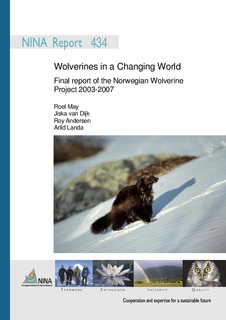Wolverines in a Changing World. Final report of the Norwegian Wolverine Project 2003-2007
Research report

Åpne
Permanent lenke
http://hdl.handle.net/11250/2397517Utgivelsesdato
2009Metadata
Vis full innførselSamlinger
- NINA Rapport/NINA Report [2341]
- Publikasjoner fra CRIStin - NINA [2364]
Originalversjon
May, R., Dijk, J. van, Andersen, R. & Landa, A. 2008. Wolverines in a Changing World. Final report of the Norwegian Wolverine Project 2003-2007. - NINA Report 434. 43 pp.Sammendrag
In 2003 the Norwegian Wolverine Project “Wolverines in a Changing World” was initiated with the principle objective to gain a better insight in the ecological role wolverines Gulo gulo have in ecosystem dynamics and their adaptation to multiple-use landscapes. This knowledge is important with respect to achieving the goals of viable and inter-connected wolverine populations, while minimizing conflicts with human interests. The project consisted of two parts; one part focussed on foraging strategies and the other part focussed on spatial ecology. The study area
was situated in southern Norway with special focus on Østerdalen where wolverines are sympatric with other large carnivores (i.e., wolf Canis lupus, Lynx lynx lynx and brown bear Ursus arctos), and the Snøhetta plateau in relation to our studies on wolverine-sheep conflicts. During the project period (2003-2007) a total of 56 different individuals were captured (13 adults and 43 cubs), mostly at secondary den sites. All adults and 11 cubs were instrumented with GPS collars and/or VHF implants.
With regard to the study on foraging strategies, wolverine diet inside and outside wolf territories were compared to see if wolverine diet shifted towards moose Alces alces (as main prey species for the wolf in this area) in the presence of wolves. As expected, we found that wolverine diet contained more moose and less reindeer Rangifer tarandus and small prey species (i.e., rodents and insectivores, birds and mountain hare Lepus timidus) in the presence of wolves. Apparently wolves increase scavenging opportunities for wolverines and the recolonization of wolves during the late nineties might therefore have contributed to the consequent recolonization of wolverine into the same area a few years later.
The study where we followed wolverine tracks in the snow revealed that in the area where wolverines are sympatric with wolves, wolverines were more active at higher elevations whereas the probability of encountering a wolf trail was higher at lower elevations. This suggests a spatial separation between wolverines and wolves. Wolverines only moved down into the forest to scavenge on relatively old wolf-killed moose carcasses (i.e., > 2 weeks old) during the winter season. Although wolverines seem to depend on wolf for carrion during winter, they did not use wolf trails to find carcasses. The use of higher elevations and the use of relative old wolf-killed moose carcasses indicate that wolverines reduce risk of intra-guild predation by avoiding direct confrontation with wolves.
Jerv, Gulo gulo, Skandinavia, Sør-Norge, sauetap, åtselspising, interaksjoner mellom rovdyr, områdebruk, furasjering, foryngling, hiplass, morsomsorg, Wolverine, Gulo gulo, Scandinavia, southern Norway, sheep, depredation, scavenging, intra-guild interactions, habitat use, foraging, reproduction, den sites, maternal care